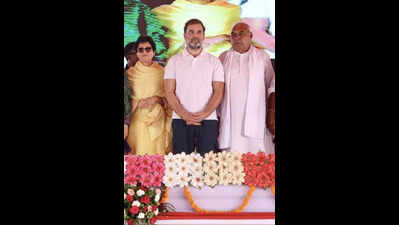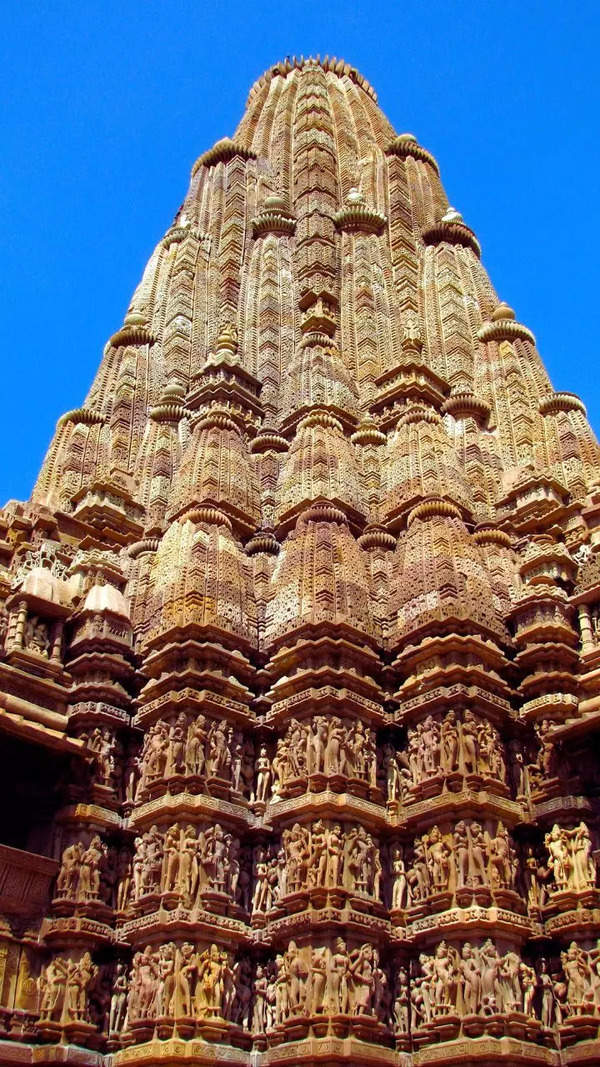- News
- City News
- chandigarh News
- This is why Congress is losing to BJP in Haryana
Trending
This is why Congress is losing to BJP in Haryana
Chandigarh: The Congress in Haryana is going through one of its most turbulent phases as it struggles to recover from its stunning defeat at the hands of the BJP in the Oct 2024 assembly elections. The loss, unofficially attributed to internal factionalism in the party, should have served as a wake-up call to the its state leadership. However, the party's state unit has failed to regroup or fortify its position. Things have reached such a low that many district-level party leaders seem eager to abandon a seemingly sinking ship which is struggling without a captain.
The party's persistent indecisiveness, particularly over appointment of the leader of opposition (LoP) in the Haryana assembly, has demoralised its legislators and grassroots workers. With 37 legislators in a house of 90 MLAs, Haryana's main opposition party is in a leadership vacuum — a situation that left CLP struggling without a leader during the assembly session in Nov, and this is expected to repeat in the budget session scheduled to start on March 7.
Disillusioned by the absence of a cohesive organisational structure and lack of organisational introspection over the assembly election defeat, some senior party leaders are gravitating towards the BJP. Former Congress MLA from Radaur, Bishan Lal Saini, joined BJP recently. Similarly, Trilochan Singh, who contested against former CM and Union minister Manohar Lal Khattar and even against current CM Nayab Saini from Karnal assembly seat, has also joined BJP. Ram Niwas Rada, who contested 2024 assembly polls from Hisar for Congress, has also switched to BJP.
Last year, several Congress stalwarts, including industrialist Navin Jindal and Kiran Choudhry, switched to the saffron party. The damage caused to the party was evident in the Lok Sabha and assembly polls. Now, Congress leaders' move to shift to BJP just before the civic polls has come as a major boost to the saffron party and a jolt to the Congress.
This state of affairs in a political party which formed the govt seven times on its own after the formation of Haryana in Nov 1966 is baffling. The party's CMs include Bhagwat Dayal Sharma, Bansi Lal, Banarasi Das Gupta, Bhajan Lal and Bhupinder Singh Hooda. Not just assembly polls, the party on numerous occasions made a clean sweep in Lok Sabha elections.
Congress CMs over time
Bhagwat Dyal Sharma | Nov 1, 1966 to March 23, 1967
Bansi Lal | May 21, 1968 to Nov 30, 1975
Banarasi Dass Gupta | Nov 1, 1975 to April 30, 1977
Bhajan Lal | May 23, 1982 to June 4, 1986, and then June 23, 1991 to May 10, 1996
Bhupinder Singh Hooda | March 5, 2005 to Oct 25, 2014
Data: Haryana CMO; *Some of these leaders had also served as CMs of govts formed by other outfits
No ground presence, no action for loss
Haryana Congress is also struggling to build party structure at the grassroots as no office-bearers have been in place for 11 years. The party is yet to identify reasons for its loss four months ago and take action against those who were instrumental in leading the party to its defeat in the assembly elections.
Political experts, senior party workers and leaders have identified several factors, with factionalism as the main reason. Former Union minister and party leader Birender Singh recently said the Congress needed to move beyond ‘individuals', former CM Bhupinder Singh Hooda in particular, for its revival in Haryana. Captain Ajay Yadav, a senior leader from south Haryana, too has said that the high command needs to take a tough stance by creating a fresh organisational structure from block to state level. Yadav, who has been associated with the party for more than four decades, considers the new party in-charge B K Hari Prasad an experienced leader, and hopes the party high command is in mood to overhaul the state unit.
Vijay Bansala, a party worker since 1982 in Panchkula district, feels frontal organisations like NSUI, Youth Congress and Mahila Congress, have been neglected and almost made defunct. "When I was in Youth Congress and Rajiv Gandhi was the Prime Minister, there used to be training camps to motivate and prepare ground-level workers. Unfortunately, BJP, which emerged much later, has workers at even 'galli' (street) level in all villages and cities. In contrast, Congress is finding it difficult to get a booth-level worker during the elections," Bansal added.
Ran Singh Maan, another senior leader, said the party should impose strict discipline by exposing those who completely hijacked the entire assembly campaign. "Tickets were distributed on personal choices and considerations in the assembly polls rather than based on survey reports or winnability/merit of candidates. Until or unless those responsible for the party's defeat are not punished or exposed, it would be difficult to revive the party," he added.
S C Goyal, a retired Haryana IAS officer who has been associated with Congress for a long time, said the Haryana unit was in a state of "unconsciousness" and if it was not provided with an immediate "sanjeevani" (life support), party's condition would be like the way it is in UP. "Udai Bhan should have immediately resigned on moral grounds. Few people who are in greed of power have demolished the party for personal interests. If a status quo is maintained, the party would gradually lose its supporters, voters and financers to survive," Goyal added.
Yoginder Singh Yogi, a prominent young leader of OBC in Haryana Congress, said Rahul Gandhi talked about uplifting backward classes, but his vision was found missing in ticket distribution in Haryana. "All sitting MLAs were given tickets despite the fact that most of them had no winnability, this way the party failed to give a chance to the second line of leadership in the state. On the other hand, BJP considered caste equations and other factors in ticket distribution but in Congress senior leaders were seen struggling to get tickets for their children/family members," Yogi added.
Ambala MP Varun Chaudhary, who belongs to one of the oldest families associated with Congress, said the current situation had demoralised the party cadre, especially due to lack of organisational structures. "We have a strong vote bank in the state and realising all our shortcomings, the party will now come up with a new structure to improve," he added
Sumita Singh, a former MLA from Karnal and senior Congress leader, said infighting had to be stopped. "Also, no party worker is there on the ground who can proudly say he holds some position in the Congress like other opposition parties because except state president, our party does not have any organisational structure," she added.
Haryana Congress, a divided house
The party unit in Haryana has three factions, of which the most influential one is led by former CM Bhupinder Singh Hooda. This faction has been accused of only promoting Hooda and his MP son
Deepender Hooda's individual interests.
Since the party's loss in 2014 polls, Hooda has been the party's key face as the leader of opposition. He also managed to get his acolyte Udai Bhan selected as president of the party's state unit, Haryana PCC. Hooda was given full authority in the Lok Sabha and assembly polls. After a good showing in the parliamentary polls, Hooda camp completely sidelined other party unit leaders in the assembly elections.
A cold war between Hooda and Kumari Selja's camp gave BJP enough ammunition to target Congress and present it as a divided house to voters.
Selja, for over a year, has been openly expressing her desire to lead the party in the state, but has strong differences with Hooda, who is keen to project Deepender as the party's CM face. The sidelining of Selja ensured she went missing from active campaigning in the run-up to the assembly polls. It was only Rahul Gandhi's rallies which ensured Hooda and Selja's presence together.
Another senior leader aspiring to lead the Haryana unit is Rajya MP from Rajasthan, Delhi-based Randeep Singh Surjewala. He is mostly missing from action in the state and mostly reacts to the state's issues by issuing statements on social media. He does not have foot workers like Hooda, but
managed his son's successful debut in politics. Aditya Surjewala is now the party MLA from his father's home ground of Kaithal. During the campaign for assembly polls, Surjewala was confined to Kaithal and did not venture out at all. Surjewala and Selja often share the stage to display unity against the Hooda camp.
Historically, a major force in Haryana
Congress has been a powerful force in Haryana and one of its most influential parties ever since the state came into existence following trifurcation of Punjab in Nov 1966. Since the first parliamentary elections held in 1967, the party has mostly registered significant victories in Haryana. Even the percentage of votes received by the party in parliamentary elections has been significantly high in most of the polls. Party could not open its account in Lok Sabha polls in Haryana only on three occasions — 1977, 1999 and 2019. However, in subsequent elections, it made a quick comeback by registering a victory on majority seats.
Although two of its stalwart leaders like Bansi Lal and Bhajan Lal had left the party on different occasions due to some differences, the party remained strong due to which both had to merge their outfits back into the Congress. In 1996, former CM Bansi Lal formed his own outfit, Haryana Vikas Party (HVP), following difference with Bhajan Lal faction. Several leaders also left the party with him. Although Bansi Lal managed to form government of HVP, he returned to the Congress and merged his party with Congress in 2004. Similarly, another Congress stalwart, Bhajan Lal, left Congress and formed his own party, Haryana Janhit Congress (HJC), after Congress chose Bhupinder Singh Hooda over him as CM in 2005. However, HJC could not succeed and ultimately merged with Congress in April 2016.
Is Hooda's time to lead party over?
Despite being given a free hand in ticket distribution with an estimated 72 of his loyalists managing to get Congress tickets in the state assembly polls, former CM Bhupinder Singh Hooda failed to secure the much-anticipated majority for the party to return to power after a 10-year hiatus.
Despite a significant wave of public sentiment seemingly favouring the Congress, the septuagenarian leader struggled to assemble a diverse and strategically adept team capable of countering the BJP's well-orchestrated ground campaign. Instead of formulating a broad-based electoral strategy that incorporated leaders from various sections
of society, Hooda appeared overly
reliant on the prevailing pro-Congress sentiment.
Throughout the campaign, the Congress's electoral narrative remained largely centred around Hooda and his son, Rohtak MP Deepender Hooda. Historically, the Congress has enjoyed a broad appeal across castes and communities in Haryana. However, this election cycle saw a visible absence of senior Congress leaders from diverse backgrounds in Hooda's campaign, creating a perception of exclusivity.
The BJP effectively capitalised on this, framing Hooda as a leader catering to only one caste — a narrative that ultimately undermined Congress prospects.
The assembly results have given enough compelling reasons to the Congress high command to reassess and re-strategise its plans for the party in future. Political experts are of the view that now the time and circumstances have changed Haryana's political landscape from 2005, when the Congress high command chose him, dislodging overambitious stalwart Bhajan Lal.
By choosing Hooda, a Jat leader, the Congress high command sent a clear message that it wanted to give the people of the state a strong alternative to the Chautala family, which had a stronghold in the rural belt and was leading INLD — the most influential regional party in Haryana. The party wanted the support of Jats in the state and that is why it chose Hooda as CM in 2005 over Bhajan Lal, who first propounded non-Jat politics in the state.
While Hooda successfully consolidated the INLD's vote bank in favour of the Congress, the BJP effectively neutralised his advantage by employing the Bhajan Lal model of politics — strategically polarising the non-Jat electorate. This tactical move allowed BJP to expand its voter base, preventing the Congress from securing a decisive victory.
For the Congress to stage a meaningful comeback in Haryana, it must reassess and recalibrate its electoral strategy. Merely banking on Jat consolidation will not suffice against the BJP's broader outreach across caste lines. A key vulnerability for Congress lies in Hooda's centralised style of leadership, which has limited the emergence of alternative power centres within the party. If the Congress aims to mount a serious challenge in future elections, it must move beyond a personality-driven approach and introduce a more inclusive leadership model — one that resonates with diverse voter groups and presents a fresh, compelling alternative to the BJP's dominance.
Besides, recruitment and land acquisition scams, and alleged lopsided development during Hooda's 10-year tenure from 2005 to 2014 would not leave him till he remains at the helm of affairs of the party in the state. A large number of criminal cases pending against Hooda would also spell trouble as he will not be able to show a clean record.
Chandigarh: The Congress in Haryana is going through one of its most turbulent phases as it struggles to recover from its stunning defeat at the hands of the BJP in the Oct 2024 assembly elections. The loss, unofficially attributed to internal factionalism in the party, should have served as a wake-up call to the party's state leadership. However, the party's state unit has failed to regroup or fortify its position. Things have reached such a low that many district-level party leaders seem eager to abandon a seemingly sinking ship which is struggling without a captain.
The party's persistent indecisiveness, particularly over appointment of the leader of opposition (LoP) in the Haryana assembly, has demoralised its legislators and grassroots workers. With 37 legislators in a house of 90 MLAs, Haryana's main opposition party is in a leadership vacuum — a situation that left CLP struggling without a leader during the assembly session in Nov, and this is expected to repeat in the budget session scheduled to start on March 7.
Disillusioned by the absence of a cohesive organisational structure and lack of organisational introspection over the assembly election defeat, some senior party leaders are gravitating towards the BJP. Former Congress MLA from Radaur, Bishan Lal Saini, joined BJP recently. Similarly, Trilochan Singh, who contested against former CM and Union minister Manohar Lal Khattar and even against current CM Nayab Saini from Karnal assembly seat, has also joined BJP. Ram Niwas Rada, who contested 2024 assembly polls from Hisar for Congress, has also switched to BJP.
Last year, several Congress stalwarts, including industrialist Navin Jindal and Kiran Choudhary, switched to the saffron party. The damage caused to the party was evident in the Lok Sabha and assembly polls. Now, Congress leaders' move to shift to BJP just before the civic polls has come as a major boost to the saffron party and a jolt to the Congress.
Congress MLAs Gokul Setia of Sirsa and Shalley Chaudhary of Naraingarh are openly lauding BJP's governance in the state, hurting their party's influence and prospects. Things are so bad that it is being speculated several senior Congress leaders are in touch with BJP and may join the ruling party in near future.
This state of affairs in a political party which formed the govt seven times on its own ever after formation of Haryana in Nov 1966 is baffling. The party's CMs include Bhagwat Dyal Sharma, Bansi Lal, Banarasi Dass Gupta, Bhajan Lal and Bhupinder Singh Hooda. Not just assembly polls, the party on numerous occasions made a clean sweep in Lok Sabha elections.
Congress CMs over time
Bhagwat Dyal Sharma | Nov 1, 1966 to March 23, 1967
Bansi Lal | May 21, 1968 to Nov 30, 1975
Banarasi Dass Gupta | Nov 1, 1975 to April 30, 1977
Bhajan Lal | May 23, 1982 to June 4, 1986, and then June 23, 1991 to May 10, 1996
Bhupinder Singh Hooda | March 5, 2005 to Oct 25, 2014
Data: Haryana CMO; *Some of these leaders had also served as CMs of govts formed by other outfits
No ground presence, no action for loss
Haryana Congress is also struggling to build party structure at the grassroots as no office-bearers have been in place for 11 years. The party is yet to identify reasons for its loss four months ago and take action against who were instrumental in leading the party to its defeat in the assembly elections.
Political experts, senior party workers and leaders have identified several factors, with factionalism as the main reason. Former Union minister and party leader Birender Singh recently said the Congress needed to move beyond ‘individuals', former CM Bhupinder Singh Hooda in particular, for its revival in Haryana. Captain Ajay Yadav, a senior leader from south Haryana, too has said that the high command needs to take a tough stance by creating a fresh organisational structure from block to state level. Yadav, who has been associated with the party for more than four decades, considers the new party in-charge B K Hari Prasad an experienced leader, and hopes the party high command is in mood to overhaul the state unit.
Vijay Bansal, a party worker since 1982 in Panchkula district, feels frontal organisations like NSUI, Youth Congress and Mahila Congress, have been neglected and almost made defunct. "When I was in Youth Congress and Rajiv Gandhi was the Prime Minister, there used to be training camps to motivate and prepare ground-level workers. Unfortunately, BJP, which emerged much later, has workers at even galli-level in all villages and cities. In contrast, Congress is finding it difficult to get a booth-level worker during the elections," Bansal added.
Ran Singh Maan, another senior leader, said the party should impose strict discipline by exposing those who completely hijacked the entire assembly campaign. "Tickets were distributed on personal choices and considerations in the assembly polls rather than based on survey reports or winnability/merit of candidates. Until or unless those responsible for the party's defeat are not punished or exposed, it would be difficult to revive the party," he added.
S C Goyal, a retired Haryana IAS officer who has been associated with Congress for a long time, said the Haryana unit was in a state of "unconsciousness" and if it was not provided with an immediate "sanjeevani" (life support), party's condition would be like in UP. "Udai Bhan should have immediately resigned on moral grounds. Few people who are in greed of power have demolished the party for personal interests. If a status quo is maintained, the party would gradually lose its supporters, voters and financers to survive," Goyal added.
Yoginder Singh Yogi, a prominent young leader of OBC in Haryana Congress, said Rahul Gandhi talked about uplifting backward classes, but his vision was found missing in ticket distribution in Haryana. "All sitting MLAs were given tickets despite the fact that most of them had no winnability, this way the party failed to give a chance to the second line of leadership in the state. On the other hand, BJP considered caste equations and other factors in ticket distribution but in Congress senior leaders were seen struggling to get tickets for their children/family members," Yogi added.
Ambala MP, Varun Chaudhary, who belongs to one of the oldest families associated with Congress, said the current situation had demoralised the party cadre, especially due to lack of organisational structures. "We have a strong vote bank in the state and realising all our shortcomings, the party will now come up with a new structure to improve," he added
Sumita Singh, a former MLA from Karnal and senior Congress leader, said infighting had to be stopped. "Also, no party worker is there on the ground who can proudly say he holds some position in the Congress like other opposition parties because except state president, our party does not have any organisational structure," she added.
Haryana Congress, a divided house
The party unit in Haryana has three factions, of which the most influential one is led by former CM Bhupinder Singh Hooda. This faction has been accused of only promoting Hooda and his MP son Deepender Hooda's individual interests.
Since the party's loss in 2014 polls, Hooda has been the party's key face as the leader of opposition. He also managed to get his acolyte Uday Bhan selected as president of the party's state unit, Haryana PCC. Hooda was given full authority in the Lok Sabha and assembly polls. After a good showing in the Lok Sabha polls, Hooda camp completely sidelined other party unit leaders in assembly polls.
A cold war between Hooda and Kumari Selja's camp gave BJP enough ammunition to target Congress and present it as a divided house to voters.
Selja, for over a year, has been openly expressing her desire to lead the party in state but has strong differences with Hooda, who is keen to project his son Deepinder as the party's CM face. The sidelining of Selja ensured she went missing from active campaign in the run-up to the assembly polls. It was only Rahul Gandhi's rallies which ensured Hooda and Selja's presence together.
Another senior leader aspiring to lead the Haryana unit is Rajya MP from Rajasthan, Delhi-based Randeep Singh Surjewala. He is mostly missing from action in the state and mostly reacts to the state's issues by issuing statements on social media. He does not have foot workers like Hooda, but managed his son's successful debut in politics. His son is the party MLA from his home ground of Kaithal. During the campaign for assembly polls, Surjewala was confined to Kaithal and did not venture out at all. Both Surjewala and Selja often share the stage to display unity against the Hooda camp.
Factors that led to current situation
No mobilisation, motivation/training of party workers
Factionalism
Area-based dominance
Senior leaders focussed on settling their children rather than strengthening party as a team
Indecisiveness on several crucial issues by party high command
No mechanism to address issues raised by senior leaders/workers in party's interest
Lack of proper organisational set-up
No discipline in party, multiple factions acting on their whims and fancies
No focus on second line of leadership
Focus on children of senior leaders
Historically, a major force in Haryana
Congress has been a powerful force in Haryana and one of its most influential parties ever since the state came into existence following trifurcation of Punjab in Nov 1966. Since the first parliamentary elections held in 1967, the party has mostly registered significant victories in Haryana. Even the percentage of votes received by the party in parliamentary elections has been significantly high in most of the polls. Party could not open its account in Lok Sabha polls in Haryana only on three occasions — 1977, 1999 and 2019. However, in subsequent elections, it made a quick comeback by registering a victory on majority seats.
Although two of its stalwart leaders like Bansi Lal and Bhajan Lal had left the party on different occasions due to some differences, the party remained strong due to which both had to merge their outfits back into the Congress. In 1996, former CM Bansi Lal formed his own outfit, Haryana Vikas Party (HVP), following difference with Bhajan Lal faction. Several leaders also left the party with him. Although Bansi Lal managed to form government of HVP, he returned to the Congress and merged his party with Congress in 2004. Similarly, another Congress stalwart, Bhajan Lal, left Congress and formed his own party, Haryana Janhit Congress (HJC), after Congress chose Bhupinder Singh Hooda over him as CM in 2005. However, HJC could not succeed and ultimately merged with Congress in April 2016.
Reassessing Congress leadership: Is Hooda's time to lead party over?
Ajay.Sura
Chandigarh: Despite being given a free hand in ticket distribution with an estimated 72 of his loyalists managing to get Congress tickets in the state assembly polls, former CM Bhupinder Singh Hooda failed to secure the much-anticipated majority for the party to return to power after a 10-year hiatus.
Despite a significant wave of public sentiment seemingly favouring the Congress, the septuagenarian leader struggled to assemble a diverse and strategically adept team capable of countering the BJP's well-orchestrated ground campaign. Instead of formulating a broad-based electoral strategy that incorporated leaders from various sections of society, Hooda appeared overly reliant on the prevailing pro-Congress sentiment.
Throughout the campaign, the Congress's electoral narrative remained largely centred around Hooda and his son, Rohtak MP Deepender Hooda. Historically, the Congress has enjoyed a broad appeal across castes and communities in Haryana. However, this election cycle saw a visible absence of senior Congress leaders from diverse backgrounds in Hooda's campaign, creating a perception of exclusivity.
The BJP effectively capitalised on this, framing Hooda as a leader catering to only one caste — a narrative that ultimately undermined Congress prospects.
The assembly results have given enough compelling reasons to the Congress high command to reassess and re-strategise its plans for the party in future. Political experts are of the view that now the time and circumstances have changed Haryana's political landscape from 2005, when the Congress high command chose him, dislodging overambitious stalwart Bhajan Lal.
By choosing Hooda, a Jat leader, the Congress high command sent a clear message that it wanted to give the people of the state a strong alternative to the Chautala family, which had a stronghold in the rural belt and was leading INLD — the most influential regional party in Haryana. The party wanted the support of Jats in the state and that is why it chose Hooda as CM in 2005 over Bhajan Lal, who first propounded non-Jat politics in the state.
While Hooda successfully consolidated the INLD's vote bank in favour of the Congress, the BJP effectively neutralised his advantage by employing the Bhajan Lal model of politics — strategically polarising the non-Jat electorate. This tactical move allowed BJP to expand its voter base, preventing the Congress from securing a decisive victory.
For the Congress to stage a meaningful comeback in Haryana, it must reassess and recalibrate its electoral strategy. Merely banking on Jat consolidation will not suffice against the BJP's broader outreach across caste lines. A key vulnerability for Congress lies in Hooda's centralised style of leadership, which has limited the emergence of alternative power centres within the party. If the Congress aims to mount a serious challenge in future elections, it must move beyond a personality-driven approach and introduce a more inclusive leadership model — one that resonates with diverse voter groups and presents a fresh, compelling alternative to the BJP's dominance.
Even recruitment and land acquisition scams, and alleged lopsided development during Hooda's 10-year tenure from 2005 to 2014 would not leave him till he remains at the helm of affairs of the party in the state. A large number of criminal cases pending against Hooda would also spell trouble as he will not be able to show a clean record.
Stay updated with breaking news, weather updates, bank holidays and upcoming public holidays in march.

About the Author
Ajay SuraEnd of Article
FOLLOW US ON SOCIAL MEDIA





